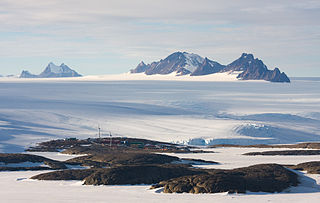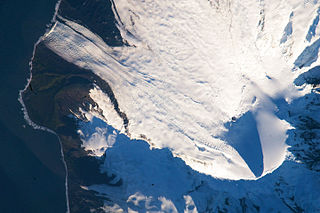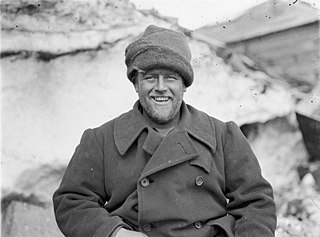
Sir Douglas Mawson OBE FRS FAA was an Australian geologist, Antarctic explorer, and academic. Along with Roald Amundsen, Robert Falcon Scott, and Sir Ernest Shackleton, he was a key expedition leader during the Heroic Age of Antarctic Exploration.

Mawson Station, commonly called Mawson, is one of three permanent bases and research outposts in Antarctica managed by the Australian Antarctic Division (AAD). Mawson lies in Holme Bay in Mac. Robertson Land, East Antarctica in the Australian Antarctic Territory, a territory claimed by Australia. Established in 1954, Mawson is Australia's oldest Antarctic station and the oldest continuously inhabited Antarctic station south of the Antarctic Circle. It houses approximately 20 personnel over winter and up to 53 in summer.

Xavier Guillaume Mertz was a Swiss polar explorer, mountaineer, and skier who took part in the Far Eastern Party, a 1912–1913 component of the Australasian Antarctic Expedition, which claimed his life. Mertz Glacier on the George V Coast in East Antarctica is named after him.

Mawson Peak is an active volcanic summit of the Big Ben massif on Heard Island, an external Australian territory in the Indian Ocean.

The Australasian Antarctic Expedition was a 1911–1914 expedition headed by Douglas Mawson that explored the largely uncharted Antarctic coast due south of Australia. Mawson had been inspired to lead his own venture by his experiences on Ernest Shackleton's Nimrod expedition in 1907–1909. During its time in Antarctica, the expedition's sledging parties covered around 4,180 kilometres (2,600 mi) of unexplored territory, while its ship, SY Aurora, navigated 2,900 kilometres (1,800 mi) of unmapped coastline. Scientific activities included meteorological measurements, magnetic observations, an expansive oceanographic program, and the collection of many biological and geological samples, including the discovery of the first meteorite found in Antarctica. The expedition was the first to establish and maintain wireless contact between Antarctica and Australia. Another planned innovation – the use of an aircraft – was thwarted by an accident before the expedition sailed. The plane's fuselage was adapted to form a motorised sledge or "air-tractor", but it proved to be of very limited usefulness.

Mawson's Huts are the collection of buildings located at Cape Denison, Commonwealth Bay, in the far eastern sector of the Australian Antarctic Territory, some 3000 km south of Hobart. The buildings were erected and occupied by the Australasian Antarctic Expedition (AAE) of 1911-1914, led by geologist and explorer Sir Douglas Mawson.

The NimrodExpedition of 1907–1909, otherwise known as the British Antarctic Expedition, was the first of three successful expeditions to the Antarctic led by Ernest Shackleton and his second expedition to the Antarctic. Its main target, among a range of geographical and scientific objectives, was to be first to the South Pole. This was not attained, but the expedition's southern march reached a Farthest South latitude of 88° 23' S, just 97.5 nautical miles from the pole. This was by far the longest southern polar journey to that date and a record convergence on either Pole. A separate group led by Welsh Australian geology professor Edgeworth David reached the estimated location of the South Magnetic Pole, and the expedition also achieved the first ascent of Mount Erebus, Antarctica's second highest volcano.

Belgrave Edward Sutton Ninnis was an English officer in the Royal Fusiliers and an Antarctic explorer who was a member of Douglas Mawson's 1911 Australasian Antarctic expedition.
John Mayston Béchervaise OAM, MBE was an Australian writer, photographer, artist, historian and explorer. He is especially notable for his work and achievements in Antarctica.

The air-tractor sledge was a converted fixed-wing aircraft taken on the 1911–1914 Australasian Antarctic Expedition, the first plane to be taken to the Antarctic.
Sidney Harry Jeffryes was an early Australian wireless telegraphy operator. Trained by Australasian Wireless Co., Ltd., he was initially employed on coastal shipping and established at least one record for distance transmission. But he is best known for his service as the wireless officer at Cape Denison during the second year of the Australasian Antarctic Expedition under the command of explorer Douglas Mawson. His service ended in September 1913, two months prior to the relief of the shore party, when Jeffryes developed symptoms of paranoia and had to be relieved of his duties.

John Hamilton Blair was a Scottish mariner, who was first officer aboard the SY Aurora during the Australasian Antarctic Expedition in 1913–1914. He later served in the Royal Navy during the First World War, where he was awarded the Distinguished Service Cross, as the head of Pangbourne Nautical College, and returned to the Navy during the Second World War.

Leslie Hatton Whetter ; was a surgeon and Antarctic explorer from New Zealand. A graduate of the University of Otago, in 1911 he joined the Australasian Antarctic Expedition (AAE), led by Douglas Mawson. During 1912, Whetter joined two sledging parties, the first to lay supplies, and the second to explore the area to the west of the Main Base at Cape Denison. On the second expedition, his party of three man-hauled a sledge 158 miles (254 km) from the Cape Denison base, and in the process discovered the first meteorite to be found in Antarctica. Mawson thought Whetter lazy, and the two clashed several times, Mawson describing Whetter as "not fit for a polar expedition".

The Far Eastern Party was a sledging component of the 1911–1914 Australasian Antarctic expedition, which investigated the previously unexplored coastal regions of Antarctica west of Cape Adare. Led by Douglas Mawson, the party aimed to explore the area far to the east of their main base in Adélie Land, pushing about 500 miles (800 km) towards Victoria Land. Accompanying Mawson were Belgrave Edward Ninnis, a lieutenant in the Royal Fusiliers, and Swiss ski expert Xavier Mertz; the party used sledge dogs to increase their speed across the ice. Initially they made good progress, crossing two huge glaciers on their route south-east.

Percy Correll (1892–1974) was a mechanic and an assistant physicist on Sir Douglas Mawson's scientific expedition to Antarctica from 1911–1914, the Australasian Antarctic Expedition.

Walter Henry Hannam (1885–1965) was an Australian wireless experimenter, a founding member of the Wireless Institute of Australia, wireless operator and mechanic on the Australasian Antarctic Expedition, a member of the ANZAC Wireless Company in World War I, and tireless promoter of amateur radio in the 1920s.

Alfred Hodgeman was an Australian architect and cartographer known for his involvement in the Australasian Antarctic expedition.
Eric Norman Webb (1889–1984) was an engineer known for his role as chief magnetician on the Australasian Antarctic Expedition.
Herbert Dyce Murphy was an Australian adventurer and raconteur. He was perhaps best known for his participation in the Australasian Antarctic Expedition.

In common with many of the expeditions of the Heroic Age, Douglas Mawson's Australasian Antarctic Expedition (AAE) employed dog-hauled sledges as a principal means of transportation during exploration of the continent. Dog sledges could carry more weight and travel faster than man-hauled sledges; they were more reliable in the freezing temperatures than motor-sledges; and dogs had proved to be more adaptable to harsh Antarctic conditions than ponies.















































